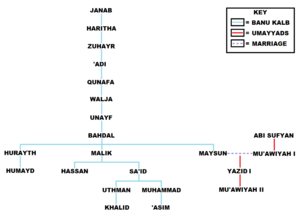Bahdal ibn Unayf al-Kalbi
| Bahdal ibn Unayf al-Kalbi | |
|---|---|
| Died | ca. mid-750s |
| Known for | Chieftain of Banu Kalb (first half of 7th century) |
| Religion | Monophysite Christianity |
| Family |
Maysun (daughter) Yazid I (grandson) Hassan ibn Malik (grandson) Sa'id ibn Malik (grandson) Humayd ibn Hurayth(grandson) |
Bahdal ibn Unayf ibn Walja ibn Qunafa al-Kalbi was the chieftain of the Banu Kalb during early Muslim rule in Syria until his death in the mid-650s. A Christian like most of his tribesmen at the time, Bahdal secured a prominent role for his family and the Banu Kalb by marrying off his daughter Maysun to the future caliph Mu'awiyah I (r. 661–680), while the latter was governor of Syria (639–661). Maysun would give birth to Mu'awiyah's son and successor, Yazid I (r. 680–683). Though Bahdal died before 657, his forging of ties with the Umayyads secured his descendants and tribesmen the most prominent positions in the Umayyad court and military, so much so that partisans of the Umayyads became known as "Baḥdaliyya". Bahdal's grandchildren led the Yaman faction in the wars with Qays, a rival tribal confederation.
Life

Bahdal belonged to the Banu Kalb's princely household, the Banu Haritha ibn Janab, and served as the tribe's preeminent chieftain.[1][2] According to medieval historian al-Tabari, Bahdal's full name and genealogy was as follows: Baḥdal ibn Unayf ibn Walja ibn Qunāfa ibn ʿAdī ibn Zuhayr ibn Ḥārithah ibn Janāb al-Kalbī.[3] He and his Bedouin tribesmen inhabited the steppes between Palmyra and Damascus by the time of the Muslim conquest of Syria in the 630s.[4][5] The Banu Kalb was among the largest tribes in Syria and commanded the wider Quda'a confederation.[5][note 1]
Though he was a Christian like most of the Banu Kalb, Bahdal forged ties with the Muslim rulers of Syria, namely from the Banu Umayya clan.[1][5] He married off his daughter Maysun to Mu'awiyah I, a member of the clan and governor of Islamic Syria.[4][5] According to historians Henri Lammens and Patricia Crone, Bahdal derived his prominence from this marriage though he did not play a political role himself.[2][7] It is not known when Bahdal was born, but he died at an old age in the mid-650s, likely before the Battle of Siffin between the partisans of the Banu Umayya and Caliph Ali in 657.[4][5] He died a Christian, and at least one of his sons and two of his daughters also remained Christians.[5]
Legacy
At the Battle of Siffin, Bahdal's grandson, Hassan ibn Malik, fought for Mu'awiyah and commanded the Quda'a contingent.[2] The Umayyads would later triumph over their rivals and Mu'awiyah became caliph in 661, moving the capital of the caliphate from Medina to Damascus. By dint of his marital links with Mu'awiyah, Bahdal was "the founder of the great prosperity of the Kalbites" during Umayyad rule (661–750), according to Lammens.[4] His household's significant influence with the early Umayyad caliphs led to partisans of the Umayyads being labeled "Baḥdaliyya".[4] Mu'awiyah's son and successor Yazid I (r. 680–683) was a grandson of Bahdal.[5][4] Meanwhile, Hassan, his brother Sa'id and another of Bahdal's grandsons, Humayd ibn Hurayth ibn Bahdal, went on to play major roles in the Umayyad administration and military, serving as governors of various Syrian provinces, commanders of various military and police units and holding high-ranking positions in the courts of caliphs Yazid I, Mu'awiyah II (r. 683–684), Marwan I (684–685) and Abd al-Malik (r. 685–705).[8] Afterward, the family largely disappeared from the historical record, though members occasionally appeared as military commanders or tribal leaders until the reign of Abbasid caliph Harun al-Rashid (r. 786–809).[9]
Notes
References
- 1 2 Lammens 1960, p. 919.
- 1 2 3 Crone 1980, p. 93.
- ↑ Al-Tabari, ed. Morony 1987, p. 215.
- 1 2 3 4 5 6 Lammens 1960, p. 920.
- 1 2 3 4 5 6 7 Marsham 2013, p. 104.
- ↑ Kister, M. J. (1986). "Kuda'a". In Bosworth, C. E.; van Donzel, E.; Lewis, B.; Pellat, Ch. The Encyclopedia of Islam, New Edition, Volume V, Khe-Mahi. Leiden and New York: BRILL. p. 315. ISBN 90-04-07819-3.
- ↑ Lammens 1960, pp. 919–920.
- ↑ Crone 1980, pp. 93–94.
- ↑ Crone 1980, p. 94.
Bibliography
- Crone, Patricia (1980). Slaves on Horses: The Evolution of the Islamic Polity. Cambridge and New York: Cambridge University Press. ISBN 0-521-52940-9.
- Lammens, Henri (1960). "Baḥdal". In Lewis, B; Pellat, Ch; Schacht, J. The Encyclopedia of Islam, Volume 1 A-B (2nd ed.). Leiden: Brill. pp. 919–920. ISBN 90-04-08114-3.
- Marsham, Andrew (2013). "The Architecture of Allegiance in Early Islamic Late Antiquity: The Accession of Mu'awiya in Jerusalem, ca 661 CE". In Beihammer, Alexander; Constaninou, Stavroula; Parani, Maria. Court Ceremonies and Rituals of Power in Byzantium and the Medieval Mediterranean: Comparative Perspectives. Leiden: Brill. ISBN 978-90-04-25686-6.
- Al-Tabari (1987). Morony, Michael G., ed. The History of al-Tabari Vol. 18: Between Civil Wars: The Caliphate of Mu'awiyah. Albany: State University of New York Press. ISBN 0-87395-933-7.